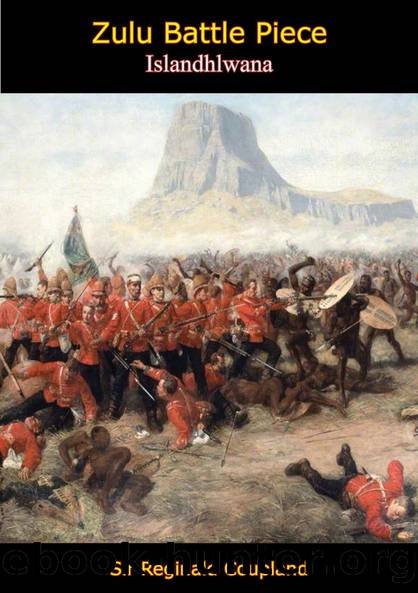Zulu Battle Piece by Sir Reginald Coupland

Author:Sir Reginald Coupland [Coupland, Sir Reginald]
Language: eng
Format: epub
Tags: History, Africa, General, North, Middle East, South, Republic of South Africa
ISBN: 9781787204607
Google: vgsqDwAAQBAJ
Publisher: Pickle Partners Publishing
Published: 2017-06-28T15:56:07+00:00
6
WHAT had happened that day at Isandhlwana? How had the Zulus managed to concentrate such an overwhelming force upon the camp?
Their advantage over the British forces in mobility has already been pointed out. They could move across any sort of terrain almost at horse speed. But they had another and even greater advantageâin âintelligence.â Chelmsford knew nothing of Zulu movements beyond a radius of a very few miles. They could move in mass by night and hide by day in folds of the undulating countryside. Even at close range large numbers could lie concealed in dongas and kranzes or in long grass. British patrols, unused to native warfare, could scarcely be blamed if they looked across a league of landscape which in fact contained thousands of Zulus and saw no sign of life in it. To the Zulus, on the other hand, whose fast-moving spies were scattered far and wide, every move the British made was plain to see. It may be taken for granted that their commanders had early information of the triple invasion and the direction of each columnâs advance.
Their strategic plan can be inferred with reasonable certainty from what took place and from the subsequent statements of prisoners in British hands.{138} From the main base at Ulundi two subsidiary holding forces were dispatched to confront the Left and Right Columns. The major force, from 25,000 to 30,000 strong, moved straight towards the Central Column. Certainly they did not contemplate a defensive strategy. They had no artillery; their firearms were relatively few and mostly antiquated flintlocks. Their strength was in the assegai and the traditional long-practised advance of the terrible Chest and Horns. When and where they came to grips with the Central Column would depend, of course, on circumstances. They would try to catch it at a disadvantage. But one part of their plan is clear. They intended to take up a position, undetected, on the columnâs left flank. Thence, outnumbering it as they did by six or seven to one, they might try to surround it. Or they could strike at its rear first, cutting its communications with Rorkeâs Drift. Or, applying the same tactics on a wider scale, they could invade Natal.
By the evening of January 20th, when the Central Column was settling down in its new camp at Isandhlwana, the first stage of this Zulu plan had been carried out. The minor Zulu forces lay some distance ahead of the Right and Left Columns. The main force, which had left Ulundi on the 17th with orders to march west by easy stages, had arrived at Isipesi Hill. They had seen some mounted white men away to their left that afternoon, evidently Chelmsford and his reconnoitring force. So, though Chelmsford had not seen them, he was right in thinking that the impi was probably somewhere in that neighbourhood at that time. But on the 21st the whole strategic situation changed. The Zulu spies must have reported the arrival of Dartnellâs troops at the head of the plain at dawn.
Download
This site does not store any files on its server. We only index and link to content provided by other sites. Please contact the content providers to delete copyright contents if any and email us, we'll remove relevant links or contents immediately.
| Central Africa | East Africa |
| North Africa | Southern Africa |
| West Africa | Algeria |
| Egypt | Ethiopia |
| Kenya | Nigeria |
| South Africa | Sudan |
| Zimbabwe |
Goodbye Paradise(3729)
Men at Arms by Terry Pratchett(2784)
Tobruk by Peter Fitzsimons(2447)
Arabs by Eugene Rogan(2263)
Borders by unknow(2232)
Pirate Alley by Terry McKnight(2187)
Belonging by Unknown(1813)
It's Our Turn to Eat by Michela Wrong(1688)
The Biafra Story by Frederick Forsyth(1617)
Botswana--Culture Smart! by Michael Main(1560)
The Source by James A. Michener(1541)
A Winter in Arabia by Freya Stark(1506)
Coffee: From Bean to Barista by Robert W. Thurston(1489)
Gandhi by Ramachandra Guha(1488)
The Falls by Unknown(1487)
Livingstone by Tim Jeal(1452)
The Shield and The Sword by Ernle Bradford(1369)
Africa: Altered States, Ordinary Miracles by Richard Dowden(1353)
Egyptian Mythology A Fascinating Guide to Understanding the Gods, Goddesses, Monsters, and Mortals (Greek Mythology - Norse Mythology - Egyptian Mythology) by Matt Clayton(1331)
